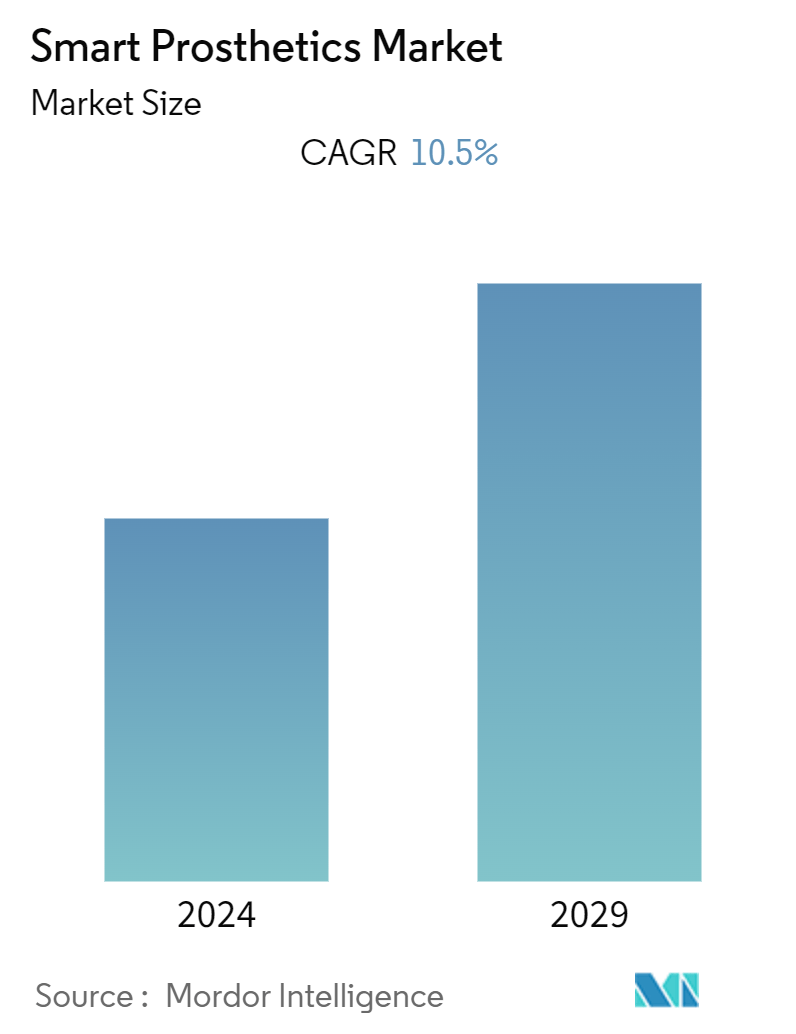Market Size of Smart Prosthetics Industry

| Study Period | 2019 - 2029 |
| Base Year For Estimation | 2023 |
| CAGR (2024 - 2029) | 10.50 % |
| Fastest Growing Market | Asia Pacific |
| Largest Market | North America |
| Market Concentration | Medium |
Major Players
*Disclaimer: Major Players sorted in no particular order |
Smart Prosthetics Market Analysis
The Smart Prosthetics Market is expected to register a CAGR of 10.5% during the forecast period.
Factors such as the growing number of sports injuries and road accidents, increasing burden of critical limb ischemia, osteosarcoma, diabetes-related amputations, and rising geriatric population, as well as increasing technological advancements in smart prosthetics, are expected to boost the market’s growth.
The prevalence of diabetic foot ulcers is expected to be the major reason for amputation among the population, which fuels the demand for lower limb prosthetics in the market. For instance, according to data published by the International Diabetes Federation in 2022, about 643 million people globally are expected to suffer from diabetes in 2030, and this number is projected to reach 784 million by 2045. As the number of diabetic cases increases, the chance of complications related to limbs undergoing amputation rises, thereby boosting market growth over the forecast period.
Additionally, the emerging technological advancements in prosthetics, such as the use of artificial intelligence, biosensor technology, and robotic prosthetics, are increasing, which is also expected to fuel market growth during the forecast period. For instance, according to an article published in Wevolver in January 2023, the development of prosthetics provides complete sensory feedback, where data is collected from sensors mounted on the prosthesis, encoded into signals, and then delivered to the brain via electrical stimulation. Such developments are anticipated to fuel the demand for smart prosthetics during the forecast period.
Furthermore, the rising adoption of key strategic activities by the market players, such as collaborations, partnerships, and fundraising, is expected to increase the availability of advanced prosthetic devices in the market. For instance, in April 2022, Ability Matters Group acquired ProActive Prosthetics Ltd to bring the company access to the Ability Matters Group's cutting-edge technologies and support the continued development of its services. In April 2022, Adapttech, a Birmingham biomedical company, received a EUR 2.25 million (USD 2.65 million) investment from MEIF Proof of Concept and Early-Stage Fund to boost its global expansion of smart devices for fitting lower limb prosthetics.
Moreover, the increasing number of product launches by market players is expected to fuel the availability of advanced prosthetics products in the market. For instance, in April 2022, Adapptech launched a new smart prosthetic limb technology, the Insight system. The Insight range of products includes INSIGHT Sense, an affordable, portable, and standalone real-time analysis pressure measurement system targeted at smaller prosthetics and orthotics clinics to reduce hardware costs and help them provide house calls to remote patients, making it faster and easier to fit lower-limb prostheses and improve patient outcomes.
Therefore, owing to factors such as the increasing number of road accidents, the rising burden of orthopedic disorders and bone cancer, and growing company activities, the market studied is anticipated to grow during the forecast period. However, the lack of developed healthcare infrastructure in developing and under-developed countries, as well as the high cost of smart prosthetics, are likely to hinder the growth of the smart prosthetics market during the forecast period.
Smart Prosthetics Industry Segmentation
As per the scope of the report, a prosthetic is an artificial body part, such as an arm or foot, that replaces a missing part. Smart prosthetics are devices that can read a user's intention from the newly rewired nerves and the muscles they activate.
The smart prosthetics market is segmented by product, end-user, and geography. By product, the market is segmented into lower-body prosthetics and upper-body prosthetics. By end user, the market is bifurcated into prosthetic clinics, hospitals, rehabilitation centers, and other end users. By geography, the market is divided into North America, Europe, Asia-Pacific, Middle East and Africa, and South America. The report offers the value (USD) for the above segments.
| By Product | |||||
| |||||
|
| By End User | |
| Prosthetic Clinics | |
| Hospitals | |
| Rehabilitation Center | |
| Other End Users |
| By Geography | ||||||||
| ||||||||
| ||||||||
| ||||||||
| ||||||||
|
Smart Prosthetics Market Size Summary
The smart prosthetics market is poised for significant growth, driven by a combination of factors including the increasing incidence of sports injuries, road accidents, and the rising prevalence of conditions such as critical limb ischemia and diabetes-related amputations. The geriatric population's expansion further contributes to the demand for advanced prosthetic solutions. Technological advancements, particularly in artificial intelligence, biosensor technology, and robotic prosthetics, are enhancing the functionality and appeal of smart prosthetics. These innovations are not only improving the quality of life for users but also driving market expansion. Strategic activities by key market players, such as collaborations, partnerships, and product launches, are increasing the availability and adoption of these advanced devices, thereby fueling market growth.
Regionally, North America is expected to experience robust growth due to its high incidence of sports-related injuries, orthopedic diseases, and diabetes-related amputations. The presence of major industry players and substantial healthcare expenditures further bolster the market in this region. Government initiatives and funding for advanced prosthetic research and development are also contributing to market dynamics. The market is moderately consolidated, with companies like Ottobock, Ossur, Esko Bionics, Blatchford Limited, and Esper Bionics leading the charge through strategic initiatives. Despite challenges such as high costs and limited healthcare infrastructure in developing regions, the smart prosthetics market is anticipated to grow steadily, supported by ongoing technological advancements and increasing product availability.
Smart Prosthetics Market Size - Table of Contents
-
1. MARKET DYNAMICS
-
1.1 Market Overview
-
1.2 Market Drivers
-
1.2.1 Growing Number of Sports Injuries and Road Accidents
-
1.2.2 Increasing Burden of Critical Limb Ischemia, Diabetes-related Amputations and Rising Geriatric Population
-
1.2.3 Technological Advancements In Smart Prosthetics
-
-
1.3 Market Restraints
-
1.3.1 Lack of Developed Healthcare Infrastructure in Developing and Under-developed Countries
-
1.3.2 High Cost of Artificial Intelligence Prosthetics
-
-
1.4 Porter's Five Forces Analysis
-
1.4.1 Threat of New Entrants
-
1.4.2 Bargaining Power of Buyers/Consumers
-
1.4.3 Bargaining Power of Suppliers
-
1.4.4 Threat of Substitute Products
-
1.4.5 Intensity of Competitive Rivalry
-
-
-
2. MARKET SEGMENTATION (Market Size by Value - USD Million)
-
2.1 By Product
-
2.1.1 Lower Body Prosthetics
-
2.1.1.1 Prosthetic Knee
-
2.1.1.2 Prosthetic Ankle
-
2.1.1.3 Other Lower Body Prosthetics
-
-
2.1.2 Upper Body Prosthetics
-
2.1.2.1 Prosthetic Arm
-
2.1.2.2 Prosthetic Hand
-
2.1.2.3 Other Upper Body Prosthetics
-
-
-
2.2 By End User
-
2.2.1 Prosthetic Clinics
-
2.2.2 Hospitals
-
2.2.3 Rehabilitation Center
-
2.2.4 Other End Users
-
-
2.3 By Geography
-
2.3.1 North America
-
2.3.1.1 United States
-
2.3.1.2 Canada
-
2.3.1.3 Mexico
-
-
2.3.2 Europe
-
2.3.2.1 Germany
-
2.3.2.2 United Kingdom
-
2.3.2.3 France
-
2.3.2.4 Italy
-
2.3.2.5 Spain
-
2.3.2.6 Rest of Europe
-
-
2.3.3 Asia-Pacific
-
2.3.3.1 China
-
2.3.3.2 Japan
-
2.3.3.3 India
-
2.3.3.4 Australia
-
2.3.3.5 South Korea
-
2.3.3.6 Rest of Asia-Pacific
-
-
2.3.4 Middle East and Africa
-
2.3.4.1 GCC
-
2.3.4.2 South Africa
-
2.3.4.3 Rest of Middle East and Africa
-
-
2.3.5 South America
-
2.3.5.1 Brazil
-
2.3.5.2 Argentina
-
2.3.5.3 Rest of South America
-
-
-
Smart Prosthetics Market Size FAQs
What is the current Smart Prosthetics Market size?
The Smart Prosthetics Market is projected to register a CAGR of 10.5% during the forecast period (2024-2029)
Who are the key players in Smart Prosthetics Market?
Blatchford Limited, Ottobock, Ossur (Touch Bionics Inc.), Esko Bionics and Esper Bionics are the major companies operating in the Smart Prosthetics Market.

